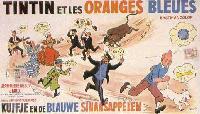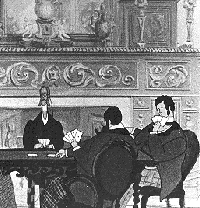

Monday, 5th AUGUST 2002
TRES MYSTERIEUX!!!

TINTIN AND THE BLUE ORANGES (1964) Professor Calculus appears on television, presenting his latest work, a book called “The Earth is Starving”. He urges the scientists of Earth to try & solve the malnutrition problem. His Spanish colleaguee, world –famous scientist Prof. Antemar Zalamea, sends him a specimen in a parcel – a blue orange, which is said to be able to grow on desert soil. But there’s a lot of interest surrounding this phosphorescent fruit and, the following night, it is stolen. Calculus goes to Spain to meet Zalamea, but before the two scientists can meet, they are kidnapped. Tintin, Captain Haddock & trusty dog Milou (that’s snowy to us Anglophones,) set off in hot pursuit, tracing the Professor to Valencia where they find their friends are being held prisoner by a fiendish arch-criminal. With the help of some children, and after much to-ing & fro-ing, Tintin and Captain Haddock managed to expose the villains and release the scientists. Anyone who’s read a Tintin book knows that the good Captain likes his drink and will try anything to have one- a highlight of the film occures when Captain Haddock finds a bottle of whiskey and attempts to get stuck into it while Tintin tries to get him to check out the clues he’s found.

Based on the characters from the comic created by Hergé. Prod. Co: Alliance de Production Cinematograf, Paris, & Production Cinematograf Rodas, Madrid. Prod: André Barret, Robert Laffont. Dist: Consortium Pathé & Procusa – Rafael Carrillo. Dir. Philippe Condroyer. Phot. Jean Badal (Eastmancolor). Mus: Antoine Duhamel Blondin. Wr. André Barret, Francisco Gonzálvez & Antonio Giménez Rico. Cast: Jean-Pierre Talbot, Jean Bouise, Félix Fernández, Bernabe Barta Barri, Salvador Beguería, Pierre Desgraupes, Max Elloy, Franky François, André Marié, Jenny Orléans, José Sazatornil, Pedro Mari Sánchez, Jesús Tordesillas, Ángel Álvarez. 105 mins. NFVLS.

(Poklad v pyramide) Hilarious cryptic chase cartoon - actually the sixth episode in the cut-out animation series THE KILLING FRAGRANCE, set in an exotic South American jungle locale, with a touch of Jules Verne, Indiana Jones ( - and Flipper!). We resume the story as brave hero-type Lucius sets Zea free from Doctor Goad and his fellow-gangsters, spoiling their plan to steal treasure hidden in a Mayan pyramid.

This sum of scenes from a never-finished, full-length animated colour feature cartoon of Jules Verne's Around The World In Eighty Days opens with the famous meeting at the Reform Club in 1872. Philéas Fogg - mysterious gentleman of British high society - wagers £20,000 that he can travel around the world in 80 days. Departing the same evening he arrives with his French servant Jean Passepartout in India, where they save a young woman about to be burned alive on a pyre. In 1937, animator & designer Anthony Gross visited American producer Hector Hopp in Switzerland– both had worked previously on LA JOIE DE VIVRE (1934) & FOX HUNT (1937) - to prepare a scenario for an animated, colour feature adaptation of the Jules Verne classic. In 1938, an international team comprised of Gross, Hoppin, David Patee, Hungarian Laszlo, composer Tibor Harsanyi, Russian cameraman Kostia Tchikine and others, established itself in Paris, to produce the first French feature-length colour animated film, financed by Alexander Korda (London Films). In 1939, Around the World gouaches were exhibited at the City of Paris' Petit Palais Exhibition, but WWII broke up the team, and the company disappeared. All traces of the work were believed to have been lost, until fragments were rediscovered in a musty projection room at the National Film Theatre, London in 1956. A reel of negatives from the London lab of TechnicolorTM was all that remained. With the assistance of the British Film Institute's Experimental Production Fund, contributing some transitional scenes, such as animated diagrams of the voyage through the Suez Canal – it was possible to construct a usable, coherent, even vivacious film of great beauty. Hoppin & Gross were innovators. Only the informed eye of a painter could have chosen the colour-pallet; -the characters are intelligently animaed, caricatured with distinction.. Of all the film projects that year arising from producers keen to follow the success of Disney's Snow White, Aroun The Work In 80 Days shines like a beacon turned towards the future. Despite some technical weaknesses and its truncated form, the film is a substantial achievement.
TechnicolorTM. Prod Co: Animat Studios. Dirs: Anthony Gross, Hector Hoppin. Narr: DONALD PLEASENCE. 17 mins. NFVLS.

BACK TO THE VAULT
SPLODGE! HOMEPAGE
HERALD SUN SPLODGE! ARTICLE